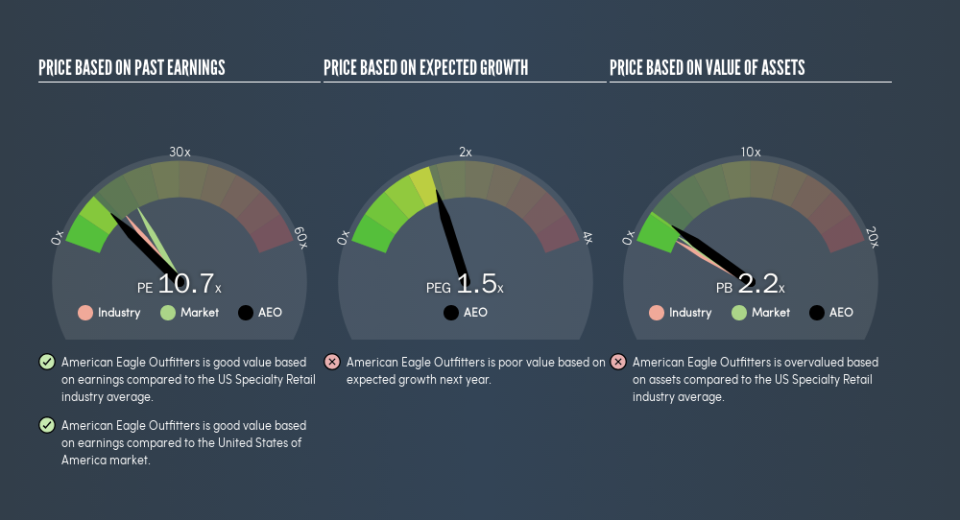Here's What American Eagle Outfitters, Inc.'s (NYSE:AEO) P/E Ratio Is Telling Us
This article is written for those who want to get better at using price to earnings ratios (P/E ratios). To keep it practical, we'll show how American Eagle Outfitters, Inc.'s (NYSE:AEO) P/E ratio could help you assess the value on offer. Based on the last twelve months, American Eagle Outfitters's P/E ratio is 10.73. That is equivalent to an earnings yield of about 9.3%.
See our latest analysis for American Eagle Outfitters
How Do You Calculate A P/E Ratio?
The formula for P/E is:
Price to Earnings Ratio = Share Price รท Earnings per Share (EPS)
Or for American Eagle Outfitters:
P/E of 10.73 = $16.07 รท $1.5 (Based on the year to May 2019.)

Is A High P/E Ratio Good?
A higher P/E ratio means that buyers have to pay a higher price for each $1 the company has earned over the last year. All else being equal, it's better to pay a low price -- but as Warren Buffett said, 'It's far better to buy a wonderful company at a fair price than a fair company at a wonderful price.'
Does American Eagle Outfitters Have A Relatively High Or Low P/E For Its Industry?
We can get an indication of market expectations by looking at the P/E ratio. If you look at the image below, you can see American Eagle Outfitters has a lower P/E than the average (13.3) in the specialty retail industry classification.

American Eagle Outfitters's P/E tells us that market participants think it will not fare as well as its peers in the same industry. While current expectations are low, the stock could be undervalued if the situation is better than the market assumes. If you consider the stock interesting, further research is recommended. For example, I often monitor director buying and selling.
How Growth Rates Impact P/E Ratios
Generally speaking the rate of earnings growth has a profound impact on a company's P/E multiple. That's because companies that grow earnings per share quickly will rapidly increase the 'E' in the equation. That means unless the share price increases, the P/E will reduce in a few years. Then, a lower P/E should attract more buyers, pushing the share price up.
It's great to see that American Eagle Outfitters grew EPS by 21% in the last year. And earnings per share have improved by 37% annually, over the last five years. With that performance, you might expect an above average P/E ratio.
Remember: P/E Ratios Don't Consider The Balance Sheet
One drawback of using a P/E ratio is that it considers market capitalization, but not the balance sheet. In other words, it does not consider any debt or cash that the company may have on the balance sheet. The exact same company would hypothetically deserve a higher P/E ratio if it had a strong balance sheet, than if it had a weak one with lots of debt, because a cashed up company can spend on growth.
While growth expenditure doesn't always pay off, the point is that it is a good option to have; but one that the P/E ratio ignores.
How Does American Eagle Outfitters's Debt Impact Its P/E Ratio?
With net cash of US$350m, American Eagle Outfitters has a very strong balance sheet, which may be important for its business. Having said that, at 13% of its market capitalization the cash hoard would contribute towards a higher P/E ratio.
The Bottom Line On American Eagle Outfitters's P/E Ratio
American Eagle Outfitters trades on a P/E ratio of 10.7, which is below the US market average of 17.4. The net cash position gives plenty of options to the business, and the recent improvement in EPS is good to see. The relatively low P/E ratio implies the market is pessimistic.
When the market is wrong about a stock, it gives savvy investors an opportunity. If it is underestimating a company, investors can make money by buying and holding the shares until the market corrects itself. So this free visual report on analyst forecasts could hold the key to an excellent investment decision.
Of course, you might find a fantastic investment by looking at a few good candidates. So take a peek at this free list of companies with modest (or no) debt, trading on a P/E below 20.
We aim to bring you long-term focused research analysis driven by fundamental data. Note that our analysis may not factor in the latest price-sensitive company announcements or qualitative material.
If you spot an error that warrants correction, please contact the editor at editorial-team@simplywallst.com. This article by Simply Wall St is general in nature. It does not constitute a recommendation to buy or sell any stock, and does not take account of your objectives, or your financial situation. Simply Wall St has no position in the stocks mentioned. Thank you for reading.
